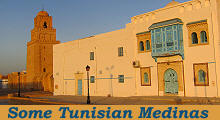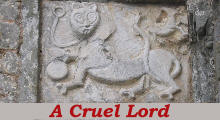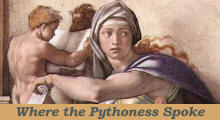  What's New! Detailed Sitemap All images © by Roberto Piperno, owner of the domain. Write to romapip@quipo.it. Text edited by Rosamie Moore. Page added in December 2012. |
 - Sousse - Sousse(the Great Minaret at Kairouan) Early XIXth century European travellers were in doubt whether Sousse were ancient Hadrumetum, the capital of Valeria Byzacena, a province created in Roman Africa by the territorial reforms introduced by Emperor Diocletian in 285-292.
Today there is general consensus on identifying Sousse with Hadrumetum, although the ancient monuments of the latter were utilized for the construction of the Great Mosque at Kairouan and mosques and fortresses at Sousse. The almost rectangular shape of the medina indicates that when the Arabs decided to repopulate Hadrumetum they did not modify the old Roman urban layout which included a straight main street which crossed the whole town. These characteristics can be observed at other ancient towns which became prosperous during the Arab rule such as Damascus.
The Kasbah (citadel adjoining the walls) of Sousse was built between the XIth and the XVth centuries around an imposing tower built in 859. At that time Sousse was the main port of Tunisia and that from which supplies were shipped to the Arab army which had invaded Sicily in 827. The tower was a manar (beacon) from which signals were made to ships, to the population of the town and to inland watch towers. The tower resembles the minaret of the Great Mosque of Kairouan.
In 1148 Sousse, as well as nearby Monastir and Mahdia, was conquered by Roger II, the Norman King of Sicily whose sovereignty was recognized by the local sheikhs. The Normans had already annexed Malta to their kingdom. The attempt to create a Christian Kingdom in Tunisia failed and by 1160 all the towns conquered by Roger II were lost. The Normans were supported in their attempt by small communities of Christians and by tribes which had resisted the process of Arabisation. The Normans were ousted from Tunisia by the Almohads, a Moroccan dynasty. The new rulers forced the Christians to convert to Islam and completely banished the use of a Latin-derived language, which was spoken in some inland regions of Tunisia.
Today the Kasbah houses the Archaeological Museum of Sousse, the second largest one in Tunisia after the Museum of Bardo in Tunis. Of particular interest is the collection of Roman mosaics found in the environs of the town. The museum was closed for renovation at the time of my visit in March 2012, but in June 2012 it was reopened to the public. One of its best known mosaics portrays Neptune on his chariot (it opens in a separate window).
In 1534 Hayruddin Barbarossa, leader of the corsairs of Algiers, intervened in a dynastic quarrel between two brothers of the Hafsid family ruling Tunisia and he conquered Tunis in the name of Ottoman Sultan Suleyman I. In the following year the troops of Emperor Charles V seized Tunis where they reinstated Mulai Hassan, the Hafsid brother who had appealed to the emperor for help. In 1537 Charles V sent a naval expedition from Sicily against Sousse which refused to submit to Mulai Hassan. The Spaniards made a vigorous assault, but were obliged to retire. In 1539 another expedition was sent, commanded by Genoese Admiral Andrea Doria, with better success; but no sooner had he left than Sousse revolted again, and welcomed the Ottoman pirate Dragut within its walls. The maritime walls of Sousse were strengthened by the addition of small bastions where artillery could be placed, but overall they retain a medieval aspect.
The medieval gates of Sousse did not give immediate access to the town; they were similar to Bab el-Jedid in Tunis where the internal gate and the external one are not aligned along the same axis. In the XIXth century they were modified to allow easier access to the town.
The ancient harbour was between the Quarantine Fort (Ribat) and Bab el-Bordj (a lost gate). The remains of the Roman breakwater may still be seen, but the accumulation of sand has rendered the water too shallow to permit vessels to make use of it. A great part of the ancient harbour is, in fact, now dry land. Some land has recently been recovered from the sea. From 1895 Murray handbook for travellers in Tunisia and Algeria. Today the old harbour has completely disappeared and a modern quarter with large hotels has been built on land reclaimed from the sea.
Arabic ribat means a fortified enclosure for religious warriors and/or a hospice for pilgrims. They were initially built at the entrances to harbours to protect them from the Byzantines, then they became hostels for pilgrims en route to Egypt and Mecca (by sea, because the journey by land was very long). The entrance to the Ribat of Sousse was embellished with columns, capitals and lintels taken from ancient buildings.
The nador (lighthouse/watch tower) of the Ribat was located at the entrance to the old harbour. It was built in 821 and it is older than the rest of the complex, the interior of which has a large courtyard surrounded by cells which indicates the original purpose of the Ribat. It was used as a quarantine location by the French administration until a new harbour was built.
The Great Mosque is situated opposite the Ribat, but on the other side of the old harbour. It is surrounded by a high crenellated wall which was strengthened by two towers/minarets. The prayer hall, similar to what can be observed at other early mosques, such as that of Damascus, is wider than long and it has two small domes above the entrance to the prayer hall and the mihrab, as at Kairouan and Tunis.
Non-Muslims can access the courtyard, but cannot enter the prayer hall which consists of sixteen short naves supported by masonry pillars with a very limited number of ancient columns used for embellishment.
The mosques and other religious buildings of Sousse were redesigned in the XVIII/XIXth centuries, but some of them retain original details. Today Sousse is the third largest city of Tunisia. Its economy mainly relies on tourism because its long sandy beaches attract holidaymakers from Europe. The souqs (markets) of the town have lost their traditional features and sell almost only to foreigners. Move to: Introductory Page Bizerte Kairouan Mahdia Monastir Sfax Tunis and An Excursion to La Goulette and Sidi Bou-Said     |











